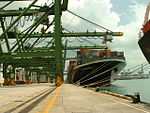Customs union
| A series on Trade |
| World trade |
|---|
 |
|
Policy
|
|
Economic integration |

A customs union is a type of trade bloc which is composed of a free trade area with a common external tariff. The participant countries set up common external trade policy, but in some cases they use different import quotas. Common competition policy is also helpful to avoid competition deficiency.[1]
Purposes for establishing a customs union normally include increasing economic efficiency and establishing closer political and cultural ties between the member countries.
It is the third stage of economic integration.
Customs unions are established through trade pacts.
List of current customs unions
Every Economic union, Customs and monetary union and Economic and monetary union has also a Customs Union
| Agreement | Date (in force) | Recent reference |
|---|---|---|
| Andean Community (CAN) | 1988-5-25 | L/6737 |
| East African Community (EAC) | 2005-1-1[2] | WT/COMTD/N/14 |
| Customs Union of Belarus, Kazakhstan and Russia | 2010-07-1[3] | |
| EU — Andorra | 1991-7-1 | WT/REG53/M/3 |
| EU — San Marino | 2002-4-1 | |
| EU — Turkey | 1996-1-1 | WT/REG22/M/4 |
| Israel — Palestinian Authority | 1994[4] | |
| Southern Common Market (MERCOSUR) | 1991-11-29 | WT/COMTD/1/Add.17 |
| Southern African Customs Union (SACU) | 1910[5] | WT/REG231/3 |
| Switzerland — Liechtenstein | 1924 |
Additionally the autonomous and dependent territories, such as some of the EU member state special territories, are sometimes treated as separate customs territory from their mainland state or have varying arrangements of formal or de facto customs union, common market and currency union (or combinations thereof) with the mainland and in regards to third countries through the trade pacts signed by the mainland state.[6]
Proposed
.png)
(each country colored according to the most advanced agreement that it participates into.)
- 2010 Common Market for Eastern and Southern Africa (COMESA)
- 2010 Southern African Development Community (SADC)
- 2011 Economic Community of Central African States (ECCAS)
- 2012 Gulf Cooperation Council (GCC)[7][8]
- 2015 Arab Customs Union (ACU)[9]
- 2015 Economic Community of West African States (ECOWAS)
- 2019 or before Union of South American Nations (UNASUR)
- 2019 African Economic Community (AEC)
- ca 2020 Closer Economic Relations of Australia and New Zealand
- Central American Common Market (CACM)[10]
Defunct
- Customs and Economic Union of Central Africa (UDEAC) - superseded by CEMAC
- 1925 French Customs Union over occupied Territory of the Saar Basin
- The former Zollverein
- Custom Union Between Lebanon and Syria[11]
- Customs Union of the Commonwealth of Independent States (CIS) and its proposed successor in the framework of Eurasian Economic Community (EurAsEC)[12]
Further reading
- The McGill University Faculty of Law runs a Regional Trade Agreements Database that contains the text of almost all preferential and regional trade agreements in the world. ptas.mcgill.ca
- Michael T. Florinsky. 1934. The Saar Struggle. New York: The Macmillan Company.
See also
- Trade diversion
- Trade creation
- List of international trade topics
- European Customs Information Portal (ECIP)
- Customs territory
References
- ↑ Winters, Alan L (1991). International Economics, Volume IV. Routledge. pp. 528 pages.
- ↑ Signed 2000-7-7, but implemented in 2005.
- ↑ Customs Union of Eurasian Economic Community (EurAsEC) envisioned in its 1997-10-8 agreement, but not implemented. WT/REG71/8
- ↑ Established following the Oslo Accords and the Paris protocol.
- ↑ latest revision is from 2004-7-15.
- ↑ EU Overseas countries and some other territories participate partially in the EU single market per part four of the Treaty Establishing the European Community; Some EU Outermost regions and other territories use the Euro of the currency union, others are part of the customs union; some participate in both unions and some in neither.
Territories of the United States, Australian External Territories and Realm of New Zealand territories share the currency and mostly also the market of their respective mainland state, but are generally not part of its customs territory. - ↑ Agreed on 2003-1-1, WT/COMTD/N/25
- ↑ GCC countries postpone customs union move
- ↑ Leaders set to approve Arab customs union
- ↑ Customs union envisioned in the 1961-10-12 agreement, but not yet implemented. WT/REG93/R/B/2
- ↑ http://countrystudies.us/lebanon/100.htm
- ↑ In the EurAsEC founding documents of 29 March 1996 a customs union is envisioned, but it was not implemented and instead in 2010 the Customs Union of Belarus, Kazakhstan and Russia was established.
External links
| |||||||||||||||||||||||
